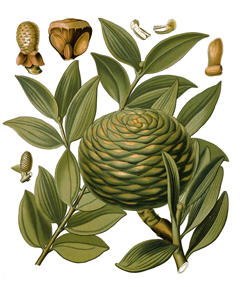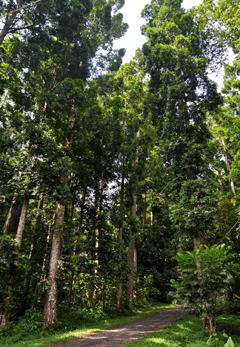 |
|
http://www.edibleplants.org/ |
 |
| wikimedia.org User:Wie146 |
Translate this page:
Summary
Amboina Pine (Agathis dammara) belongs in the Araucariaceae family. It is a medium-large, tapering, conical shape evergreen tree that grows up to 50 – 65 meters tall and is found in the Philippines and Indonesia. Its bole can be up to 1.8 meters in diameter. Though commonly grown as ornamental, Amboina Pine is also known as a major source of Dammar resin, which is widely used in medicine. The bark is scaly and fibrous and is burnt to repel mosquitoes. The tree has no known edible feature.
Physical Characteristics

 Agathis dammara is an evergreen Tree growing to 50 m (164ft) by 15 m (49ft) at a medium rate.
Agathis dammara is an evergreen Tree growing to 50 m (164ft) by 15 m (49ft) at a medium rate.
See above for USDA hardiness. It is hardy to UK zone 10 and is frost tender. The flowers are pollinated by Wind.
Suitable for: light (sandy), medium (loamy) and heavy (clay) soils, prefers well-drained soil and can grow in nutritionally poor soil. Suitable pH: mildly acid, neutral and basic (mildly alkaline) soils and can grow in very acid and very alkaline soils.
It can grow in full shade (deep woodland) semi-shade (light woodland) or no shade. It prefers moist soil.
UK Hardiness Map
US Hardiness Map
Synonyms
Abies dammara (Lamb.) Poir. Agathis alba (Rumph. ex Hassk.) Foxw. Agathis celebica (Koord.) Warb. Ag
Plant Habitats
Edible Uses
References More on Edible Uses
Medicinal Uses
Plants For A Future can not take any responsibility for any adverse effects from the use of plants. Always seek advice from a professional before using a plant medicinally.
None Known
References More on Medicinal Uses
The Bookshop: Edible Plant Books
Our Latest books on Perennial Plants For Food Forests and Permaculture Gardens in paperback or digital formats.

Edible Tropical Plants
Food Forest Plants for Hotter Conditions: 250+ Plants For Tropical Food Forests & Permaculture Gardens.
More

Edible Temperate Plants
Plants for Your Food Forest: 500 Plants for Temperate Food Forests & Permaculture Gardens.
More

More Books
PFAF have eight books available in paperback and digital formats. Browse the shop for more information.
Shop Now
Other Uses
Insecticide Resin Varnish Wood
Agroforestry Uses: It is cultivated as a plantation tree and used in enrichment planting and reforestation schemes in various areas within the natural range[ 325 ]. Other Uses The trunk richly contains the famous dammar resin, which is widely used in industry and medicine[ 266 ]. The resin is graded into hard, semi-hard and soft[ 46 ]. It is used for varnishing enamels and interior work[ 46 ]. The resin used to be an important component of varnish and was used in the production of linoleum[ 325 ]. Much of the quality of the resin depends upon the age of the product since it can be obtained both from living trees or from the soil in semi-fossil condition[ 46 ]. Harvesting of the resin commences when the bole is around 25cm in diameter (approx 20 years old). Triangular cuts (becoming circular with age) are arranged in vertical rows around the trunk. The cuts are several centimetres wide at first, but become enlarged at every tapping and eventually become holes of 15 - 20cm in depth and width. The average number of holes for a tree about 30 metres tall and 60 - 80cm in diameter is 9 - 11 in each of 4 - 5 vertical rows. For the higher holes, the tapper climbs the tree supported by a rattan belt and using the lower holes as footholds. The exuded resin is allowed to dry on the tree before it is collected. The frequency with which the tree is visited to refreshen the cut varies from once a week to once a month, depending on how far the tree is from the village. Tapping can continue for 30 years[ 891 ]. The scaly, fibrous bark is burnt to deter mosquitoes[ 307 ]. The heartwood is a pale cream, golden brown, to dark reddish or yellowish brown if resinous; it is usually not distinct from the sapwood[ 316 ]. The wood is lustrous; the grain mainly straight; texture fine and uniform; generally without distinctive odour or taste[ 316 ]. It is generally not durable, vulnerable to termite attack and prone to blue stain[ 316 ]. It works easily with hand and machine tools, finishes with a clean smooth surface; has good nailing and screwing properties; good veneer peeling characteristics; paints and polishes well; easy to glue[ 316 ]. It is used for a range of purposes, including vats and tanks, patternmaking, millwork, boatbuilding, furniture components, face veneers, shingles and pencil slats[ 316 ]. It is used as a general purpose softwood for construction, boat masts, joinery, household utensils, matches, veneer, packaging, moulding, plywood and pulpwood[ 266 , 325 ].
Special Uses
Food Forest
References More on Other Uses
Cultivation details
A plant of the subhumid highlands in the tropics, where it is found at elevations from 300 - 1,600 metres[ 325 , 418 ]. It grows best in areas where annual daytime temperatures are within the range 28 - 34°c, but can tolerate 12 - 38°c[ 418 ]. It prefers a mean annual rainfall in the range 2,500 - 3,500mm, but tolerates 2,000 - 4,000mm[ 418 ]. Older trees grow well in sunny positions, but need the shady, sheltered conditions of the woodland when small[ 418 ]. Plants can grow on a variety of soils, including podzolized sands (in heath forest), ultrabasic soils, limestone, igneous and sedimentary rocks[ 325 ]. The root system is sensitive to a lack of oxygen and the species does not tolerate waterlogging[ 325 ]. Prefers a pH in the range 5.5 - 6.5, tolerating 5 - 7.5[ 418 ]. Seedling plants need shade, and growth is slow during the first year. Later, when released from competition from weeds, growth is more rapid[ 325 ]. Trees can commence producing cones when about 15 years old, though viable seeds are not usually produced before they are 25 years old[ 325 ].
References Carbon Farming Information and Carbon Sequestration Information
Temperature Converter
Type a value in the Celsius field to convert the value to Fahrenheit:
Fahrenheit:
The PFAF Bookshop
Plants For A Future have a number of books available in paperback and digital form. Book titles include Edible Plants, Edible Perennials, Edible Trees,Edible Shrubs, Woodland Gardening, and Temperate Food Forest Plants. Our new book is Food Forest Plants For Hotter Conditions (Tropical and Sub-Tropical).
Shop Now
Plant Propagation
Seed - it cannot tolerate desiccation and does not store for much more than 2 months in normal conditions. It does not require pre-treatment. Sowing is done with the wing part of the seed pointing upwards and 66% of the seed buried in the soil. Germination commences within 6 days, with 90 - 100% germination rates within 10 days[ 325 ]. Cuttings of leading shoots[ 307 ].
Other Names
If available other names are mentioned here
Native Range
TROPICAL ASIA: Indonesia (Sulawesi, Maluku), Philippines
Weed Potential
Right plant wrong place. We are currently updating this section.
Please note that a plant may be invasive in one area but may not in your area so it's worth checking.
Conservation Status
IUCN Red List of Threatened Plants Status : Agathis dammara (Amboina Pitch Tree)
Status: Vulnerable A4cd ver 3.1
Pop. trend: decreasing

Growth: S = slow M = medium F = fast. Soil: L = light (sandy) M = medium H = heavy (clay). pH: A = acid N = neutral B = basic (alkaline). Shade: F = full shade S = semi-shade N = no shade. Moisture: D = dry M = Moist We = wet Wa = water.
Now available:
Food Forest Plants for Mediterranean Conditions
350+ Perennial Plants For Mediterranean and Drier Food Forests and Permaculture Gardens.
[Paperback and eBook]
This is the third in Plants For A Future's series of plant guides for food forests tailored to
specific climate zones. Following volumes on temperate and tropical ecosystems, this book focuses
on species suited to Mediterranean conditions—regions with hot, dry summers and cool, wet winters,
often facing the added challenge of climate change.
Read More
Expert comment
Author
(Lamb.) Rich.
Botanical References
46325
Links / References
For a list of references used on this page please go here
A special thanks to Ken Fern for some of the information used on this page.
Readers comment
| Add a comment |
|
If you have important information about this plant that may help other users please add a comment or link below. Only comments or links that are felt to be directly relevant to a plant will be included. If you think a comment/link or information contained on this page is inaccurate or misleading we would welcome your feedback at [email protected]. If you have questions about a plant please use the Forum on this website as we do not have the resources to answer questions ourselves.
* Please note: the comments by website users are not necessarily those held by PFAF and may give misleading or inaccurate information.
To leave a comment please Register or login here All comments need to be approved so will not appear immediately.
|
Subject : Agathis dammara
|
|
|
|